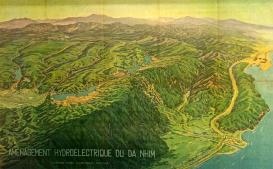My project examines the history of Japan's overseas development system in Asia from its origins in Japan's colonial rule over much of Asia before 1945 to its rise to become the world's leading aid donor by the end of the Cold War in 1989. By analyzing how Japan's international development system evolved at major project sites in East and Southeast Asia, I examine how Japan projected economic and political power as a US Cold War ally through overseas development based on its earlier colonial legacies and networks in Asia. Challenging a Western-focused narrative of the Cold War, I examine the concrete flows of capital, ideas, people, and technology at specific Japanese infrastructure projects throughout Asia, thereby highlighting how regional dynamics and exchanges within Asia over the trans-war era dynamically shaped the Cold War.
By examining four high-profile projects conducted in South Vietnam, Laos, Indonesia, and South Korea during the Cold War by Nippon Kōei—a consultancy started by engineers who had extensive experience planning and constructing infrastructure projects during Japan's colonial era—my new project traces the formation of the colonial concept of "comprehensive development" in the postcolonial context as a form of knowledge and techno-scientific power. The projects studied are the Da Nhim multipurpose dam in South Vietnam, the Nam Ngum Dam in Laos as part of the Mekong River Development Project, Indonesia's Brantas River Basin Project, and South Korea's first multipurpose project, Somjingang Dam. Each site presents a different configuration of actors, natural environments, sociopolitical issues, and international forces that reveal how "comprehensive development" emerged out of various contexts and positioned itself as flexible in scale and scope.

Nippon Kōei, "Dha Nhim Hydroelectric Development" (1956). Blueprint for hydropower project in South Vietnam, Nippon Kōei Kabushiki Kaisha, Betonamu shakaishugi kyōwakoku Da Nimu dengen kaihatsu (Tokyo: Nippon Kōei Kabushiki Kaisha, 2010), back cover.
Project
(2017)
